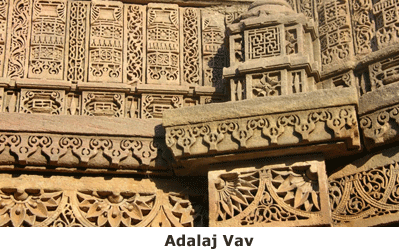ADALAJ VAV................................................................................................................................................................................................................................................................................... Adalaj is a small village, situated at a distance of 18 km to the north of Ahmedabad. Vav means a step well. Adalaj Vav was built by Queen Rudabai, in 1499 AD. She was the wife of the Vaghela chief, Veer Sinh. A beautifully chiseled step well, Adalaj Vav is counted amongst the finest architectural structures of Gujarat. According to the folklore, Sultan Beghara killed the Vaghela King, Veer Sinh, in order to expand his territory. He then sent a marriage proposal to his wife, Queen Rudabai. She begged for sometime from the Sultan, so that she could complete the Vav that she was building in the memory of her loving husband. The Sultan agreed without knowing the true intentions of the queen. Queen Rudabai dragged the construction work for 20 long years. Losing patience, the Sultan again insisted for marriage. He queen reciprocated by jumping from one of the balconies in the well. It is said that she took Jal Samadhi in order to save her honor and to please the Jal Devi to maintain constant flow of water in the well. Adalaj Vav is adorned with intricate carvings and splendid sculptures. The walls of the well depict figures of flowers, birds, fish and other ornamental designs. There are a number of corridors and platforms surrounding the well. The three entrances contain steps that reach upto the stepped corridors. These corridors meet on a platform, which has an octagonal opening on the top. The missing canopy of the well tells us that it is still not complete. The unique feature of Adalaj Vav is that apart from conserving water for drinking purposes, it also serves as a cooling chamber in the hot summer months. The steps of the well were used by the travelers and caravans passing from the area, on the due course of their trade routes. With time, the well has become a memorial of the love of the queen for her husband. One can still see water in the well which is a living example of spirit of the queen.
|
||||||||||||
|
|
||||||||||||




